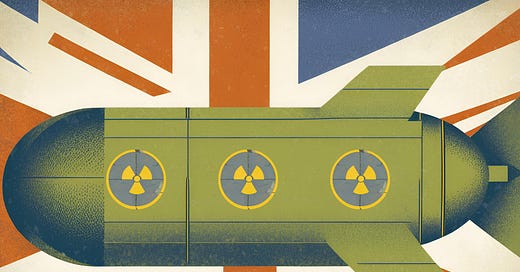
The case for a British sub-strategic nuclear deterrent
The Memorandum | No. 15.2025
Under the leadership of Donald Trump, the United States (US) has made it clear that it expects the United Kingdom (UK) and European countries to do more to uphold Euro-Atlantic security as it prioritises East Asia. The new administration also may be seeking to drive a wedge between Russia and the People’s Republic of China (PRC) – or at least slow down the speed at which Russia falls into the Sinosphere – which means it may be prepared to overlook the Kremlin’s excesses in Eastern Europe. This would be deeply problematic for Britain.
If Russia is allowed to prevail in Ukraine, Moscow will attempt to roll back the North Atlantic Treaty Organisation (NATO) and create a sphere of influence in Eastern and Central Europe where it is suzerain, undermining European security and jeopardising British interests. It should not be forgotten that the Kremlin sees His Majesty’s (HM) Government as its foremost rival, which it may seek to punish for assisting Ukraine.
At the same time, Russia’s political leaders and military commanders are not shy of their nuclear arsenal. They see nuclear weapons as tools of political coercion and battlefield ordnance, unlike their British counterparts, who traditionally see nuclear forces as weapons of last resort. Also, unlike the UK (see: Box 1), Russia has multiple different nuclear delivery systems, from the strategic to the sub-strategic, and can move through every conceivable phase of escalation. Absent the cover provided by the comprehensive American nuclear umbrella, Britain may be less able (or willing) to respond to (and deter) the Kremlin’s escalatory efforts without the ability to mount a proportional response of its own.
Box 1: The British nuclear deterrent
Uniquely among the five established nuclear powers, the UK has opted for a single delivery system for its nuclear weapons. Britain’s nuclear arsenal is in the hands of the Royal Navy. Based on four Vanguard class nuclear-powered ballistic missile submarines (SSBNs), the deterrent is continuously at sea. Maxed out, each British SSBN can carry 16 Trident II missiles, which together can hold 192 warheads, each with a yield of up to 100 kilotons. However, the deterrent has never operated at maximum capacity and it was further reduced in the 2010 Strategic Defence and Security Review to only eight Trident II missiles, containing 40 warheads. It is not clear if this approach has been modified given that HM Government recommitted to a policy of ‘strategic ambiguity’ and pledged to increase the stockpile of available nuclear warheads in the 2021 Integrated Review.
Although it is feasible for Britain to use Trident in the sub-strategic role – each of the Royal Navy’s SSBNs are equipped with one Trident missile armed with a single low-yield warhead – its use in such a role would increase the risk of the SSBN’s detection, and thus interception. Even then, the sub-strategic launch of a Trident II missile runs the risk of inadvertent escalation since Russia may misinterpret it as a strategic one aimed at its national centres of gravity, leading it to respond in kind.
But the growing uncertainty of American intentions does not affect only Britain. So unnerved are the Poles and Germans that Donald Tusk, Prime Minister of Poland, and Friedrich Merz, the probable next Chancellor of Germany, have called for the creation of additional layers of nuclear deterrence beyond those provided by America. Recent polls in Germany show there is increasing support for such an initiative. There is a growing risk that Poland and Germany, as well as Norway, Sweden, Finland and Romania, will look to others for nuclear security. Absent British leadership, their only option would be to look to France, the other European nuclear power in NATO. If Paris is willing to modify its nuclear doctrine and take measures to extend its nuclear umbrella over European allies, France would almost certainly gain pervasive influence – even executive power – over the direction of European geopolitics.
Another risk is that Poland and others may begin the development of their own nuclear weapons. Nuclear proliferation might enhance European states’ ability to deter Russian aggression in the long-term by creating additional centres of nuclear decision making. Proliferation would have other adverse consequences, though, including undermining the nuclear non-proliferation regime. Nuclear proliferation would also unbalance European dynamics, creating a new order of ‘haves’ and ‘have nots’, and would risk pre-emptive Russian military interventions.
Here there should be no misunderstanding; due to its history and geography, Poland, above all others – and irrespective of the colour of the ruling party in Warsaw – will do everything in its power to prevent the growth of Russian power in Eastern Europe. And Poland now has an increasingly sophisticated economy which has experienced high growth in recent years; it is not beyond Poland’s capacity to develop a nuclear deterrent, which, due to geographic proximity, would not need to be extensive to force the Kremlin to factor it into any strategic calculations. However, building an independent nuclear deterrent would take time – perhaps a decade – and consume substantial resources which could otherwise be devoted to conventional rearmament.
Consequently, the time has come for the UK to regenerate a sub-strategic nuclear deterrent…While other options to boost deterrence at the sub-strategic level exist – such as offensive cyber, massive ordnance air blast weapons, and conventional deep strike – nothing deters (or reassures) like nuclear forces, especially when they provide flexibility in terms of response.
Consequently, the time has come for the UK to regenerate a sub-strategic nuclear deterrent. This has nothing to do with the yield of nuclear warheads: a sub-strategic (or ‘theatre level’) capability is determined by the delivery method, which should not be strategic, i.e., via intercontinental ballistic missiles launched from silos or submarines. While other options to boost deterrence at the sub-strategic level exist – such as offensive cyber, massive ordnance air blast weapons, and conventional deep strike – nothing deters (or reassures) like nuclear forces, especially when they provide flexibility in terms of response. While potentially highly disruptive, cyber attacks lack the aura of extreme violence, massive ordnance air blast weapons are cumbersome and therefore vulnerable to interception, and conventional deep strike would not be enough to reassure nervous allies.
Britain maintained a sub-strategic nuclear system until 1998, when nuclear depth charges and free-fall bombs based on the WE.177 warhead were withdrawn from service due to the end of the Cold War. The regeneration of such a capability would provide the UK with a number of potent advantages.
First, it would provide additional layers of deterrence; Russia may feel less confident in testing British resolve along NATO’s frontier knowing that HM Government has nuclear options beyond a full strategic strike should conflict escalate quickly. Britain’s closest NATO allies would like to see the development of a British sub-strategic deterrent.
Second, with another layer of nuclear capability, Britain would be less dependent on the whims of the American president. While full operational control rests in the hands of the Prime Minister, Trident II missiles are ultimately dependent on the US for long-term maintenance. Should the Americans threaten to withdraw support because of differences over geostrategic policy, HM Government may feel compelled to accept US demands due to the fact that it would take emergency and very costly measures to stand up a fully autonomous British system. Having an alternative, albeit less powerful, nuclear system may dissuade the Americans from ever threatening such an outcome should they come to disfavour a particular British policy.
Finally, a British sub-strategic nuclear deterrent would ensure that France is not left as the primary nuclear power in Europe. Indeed, if the UK were to share sub-strategic weapons with nervous allies such as Poland, Germany, Finland and Romania, similarly to the way in which the Americans share their nuclear bombs with Belgium, Germany, Italy and Turkey, Europeans may be discouraged from looking to France also for security guarantees – with all the political influence Paris would gain – or opting to stand up their own nuclear programmes. It would increase their reliance on the UK instead, with all the resulting benefits in terms of geopolitical influence.
In terms of cost, the development of a British sub-strategic nuclear system would not be cheap; but it would not be excessively expensive either, especially if European allies such as Germany, Poland and others help to finance it. There are a range of options, from attempting to remake the WE.177 gravity bombs and depth charges the UK relinquished in the 1990s, to refitting modified Trident II warheads to Storm Shadow cruise missiles.
In sum, due to the severity of the situation in Europe, the fastest route to delivery should be sought, not the most exquisite capability. To generate maximum flexibility in terms of escalation management and strategic advantage in terms of geopolitical control over European affairs, HM Government should begin looking at options to stand up a British sub-strategic deterrent, without delay.
Dr Marc De Vore is Senior Lecturer at the University of St. Andrews and the Sir Halford Mackinder Associate Fellow in Black Sea Geopolitics at the Council on Geostrategy. He writes in a personal capacity.
James Rogers is Co-founder (Research) at the Council on Geostrategy.
To stay up to date with Britain’s World, please subscribe or pledge your support!
What do you think about this Memorandum? Why not leave a comment below?













One of the most profound and importent articles of common sence I have read for a long time.
I really hope the uk government bites the proverbial bullet with this critical subject.